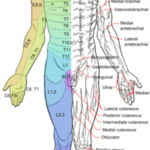Neuropathy of the autonomic nervous system results in a broad range of dysfunctions affecting almost every organ system of the body.
Three manifestations of autonomic neuropathy is related to the cardiac, GI, and renal systems cardiovascular symptoms range from fixed, slightly tachycardic heart rate; orthostatic hypotension; and silent, or painless, myocardial ischemia and infarction.
Delayed gastric emptying may occur with the typical symptoms of early satiety, bloating, nausea, and vomiting. In addition, there may be unexplained wide swings in blood glucose levels related to inconsistent absorption of the glucose from ingested foods secondary to the inconsistent gastric emptying.
Diabetic constipation or diarrhea especially nocturnal diarrhea may occur as a result. Urinary retention, a decreased sensation of bladder fullness, and other urinary symptoms of neurogenic bladder are predisposed to developing urinary tract infections due to inability to completely empty the bladder. This is especially true in patients with poorly controlled diabetes, because hyperglycemia impairs resistance to infection.
Hypoglycemic unawareness
Autonomic neuropathy of the adrenal medulla is responsible for diminished or absent adrenergic symptoms of hypoglycemia. Patients may report that they no longer feel the typical shakiness, sweating, nervousness, and palpitations associated with hypoglycemia.
Strict blood glucose monitoring, including frequent SMBG, is recommended for these patients. Their inability to detect and treat these warning signs of hypoglycemia puts them at risk for developing dangerously low blood glucose levels.
Therefore, their goals for blood glucose levels may need to be adjusted to reduce the risk for hypoglycemia. The patient and family need to be taught to recognize subtle signs and symptoms of hypoglycemia.
Management
Management strategies depend on the symptoms. There is no treatment for painless cardiac ischemia, and the prognosis is poor. Detection, however, is important so that education about avoiding strenuous exercise can be provided.
Orthostatic hypotension may respond to diet high in sodium, the discontinuation of medications that impede autonomic nervous system responses, the use of sympathomimetics and other agents that stimulate an autonomic response, and the use of lower-body elastic garments that maximize venous return and prevent pooling of blood in extremities.
Treatment of delayed gastric emptying includes a low-fat diet, frequent small meals, close blood glucose control, and use of agents that increase gastric motility like metoclopramide, and bethanechol.
Treatment of diabetic diarrhea may include bulkforming laxatives or antidiarrheal agents. Constipation is treated with high fiber and adequate hydration; medications, laxatives, and enemas may be necessary when constipation is severe. Treatment of sudomotor dysfunction focuses on education about skin cares and heat intolerance.
Diabetic Neuropathy of the Peripheral Nerves
One type of Diabetic Neuropathy is sensorimotor polyneuropathy or also known as peripheral neuropathy. Initial symptoms of peripheral neuropathy include paresthesias (prickling, tingling, or heightened sensation) and burning sensation (especially at night).
As the neuropathy progresses, the feet become numb. In addition, a decrease in proprioception (awareness of posture and movement of the body and of position and weight of objects in relation to the body) and a decreased sensation of light touch may lead to an unsteady gait. Decreased sensations of pain and temperature place patients with neuropathy at increased risk for injury and undetected foot infections. Deformities of the foot may also occur, with neuropathy-related joint changes producing Charcot joints. These joint deformities result from the abnormal weight distribution on joints due to lack of propriocetion.
On physical examination, a decrease in deep tendon reflexes and vibratory sensation is found. For patients who have few or no symptoms of neuropathy, these physical findings may be the only indication of neuropathic changes. For patients with signs or symptoms of neuropathy, it is important to rule out other possible neuropathies, including alcohol-induced or vitamin-deficiency neuropathies.
Intensive insulin therapy and control of blood glucose levels delay the onset and slow the progression of neuropathy. Pain, particularly of the lower extremities, is a distributing symptom in some people with neuropathy secondary to diabetes. For some patients, neuropathic pain spontaneously resolves within 6 months. For other patients, pain persists for many years. Various approaches to pain management can be tried. These include analgesics (preferably nonopiod); tricyclic antidepressants; phenytoin, carbamazepine, or gabapentin (antiseizure medications); mexiletine (an anti-arrytmic); or transcutaneous electrical nerve stimulation (TENS).
The use of aldose reductase inhibitors is under study to determine whether they block the damaging effects of hyperglycemia. The topical medication capsaicin (Axscain) also has been shown in preliminary reports to decrease lower-extremity neuropathic pain. Studies of the role of this topical medication in neuropathy continue.




